Hydrogels for Three-Dimensional Ionizing-Radiation Dosimetry
Abstract
:1. Introduction
2. Fricke Gels
2.1. Radiation Chemistry
2.2. Formulations
2.3. Characterization and Performance
2.3.1. Gelation Process
2.3.2. Reagent Purity and Reproducibility
2.3.3. Response to Ionizing Radiation
2.3.4. Ferric Ion Diffusion Effects
2.3.5. Spontaneous Oxidation
2.3.6. Recent Developments: Functionalized, Doped and Reusable Fricke Gels
3. Polyacrylamide Gels
3.1. Radiation Chemistry
3.2. Preparation
3.3. Characterization and Performance
4. Readout Techniques
4.1. Magnetic Resonance Imaging
4.2. Optical Computed Tomography
4.3. X-ray Computed Tomography
4.4. Ultrasound Imaging
5. Conclusions
Author Contributions
Funding
Acknowledgments
Conflicts of Interest
References
- UNSCEAR. United Nations Scientific Committee on the Effects of Atomic Radiation Reports. Available online: https://www.unscear.org/ (accessed on 19 June 2021).
- D’Errico, F. Dosimetric issues in radiation protection of radiotherapy patients. Radiat. Prot. Dosim. 2006, 118, 205–212. [Google Scholar] [CrossRef]
- Bouchard, H.; Seuntjens, J.; Carrier, J.F.; Kawrakow, I. Ionization chamber gradient effects in nonstandard beam configurations. Med. Phys. 2009, 36, 4654–4663. [Google Scholar] [CrossRef]
- Griessbach, I.; Lapp, M.; Bohsung, J.; Gademann, G.; Harder, D. Dosimetric characteristics of a new unshielded silicon diode and its application in clinical photon and electron beams. Med. Phys. 2005, 32, 3750–3754. [Google Scholar] [CrossRef]
- Porumb, C.S.; Aldosari, A.H.; Fuduli, I.; Cutajar, D.; Newall, M.; Metcalfe, P.; Carolan, M.; Lerch, M.L.; Perevertaylo, V.L.; Rosenfeld, A.B.; et al. Characterisation of silicon diode arrays for dosimetry in external beam radiation therapy. IEEE Trans. Nucl. Sci. 2016, 63, 1808–1817. [Google Scholar] [CrossRef] [Green Version]
- Kry, S.F.; Alvarez, P.; Cygler, J.E.; DeWerd, L.A.; Howell, R.M.; Meeks, S.; O’Daniel, J.; Reft, C.; Sawakuchi, G.; Yukihara, E.G.; et al. AAPM TG 191: Clinical use of luminescent dosimeters: TLDs and OSLDs. Med. Phys. 2020, 47, e19–e51. [Google Scholar] [CrossRef] [PubMed] [Green Version]
- Devic, S.; Tomic, N.; Lewis, D. Reference radiochromic film dosimetry: Review of technical aspects. Phys. Med. 2016, 32, 541–556. [Google Scholar] [CrossRef]
- Oldham, M. Methods and techniques for comprehensive 3D dosimetry. Adv. Med. Phys. 2014, 5, 69–86. [Google Scholar]
- Gore, J.; Kang, Y. Measurement of radiation dose distributions by nuclear magnetic resonance (NMR) imaging. Phys. Med. Biol. 1984, 29, 1189. [Google Scholar] [CrossRef]
- Appleby, A.; Christman, E.; Leghrouz, A. Imaging of spatial radiation dose distribution in agarose gels using magnetic resonance. Med. Phys. 1987, 14, 382–384. [Google Scholar] [CrossRef]
- Gambarini, G.; Arrigoni, S.; Cantone, M.; Molho, N.; Facchielli, L.; Sichirollo, A. Dose-response curve slope improvement and result reproducibility of ferrous-sulphate-doped gels analysed by NMR imaging. Phys. Med. Biol. 1994, 39, 703. [Google Scholar] [CrossRef] [PubMed]
- Luciani, A.; Di Capua, S.; Guidoni, L.; Ragona, R.; Rosi, A.; Viti, V. Multiexponential relaxation in Fricke agarose gels: Implications for NMR dosimetry. Phys. Med. Biol. 1996, 41, 509. [Google Scholar] [CrossRef]
- Maryanski, M.J.; Gore, J.C.; Kennan, R.P.; Schulz, R.J. NMR relaxation enhancement in gels polymerized and cross-linked by ionizing radiation: A new approach to 3D dosimetry by MRI. Magn. Reson. Imaging 1993, 11, 253–258. [Google Scholar] [CrossRef]
- Fong, P.M.; Keil, D.C.; Does, M.D.; Gore, J.C. Polymer gels for magnetic resonance imaging of radiation dose distributions at normal room atmosphere. Phys. Med. Biol. 2001, 46, 3105. [Google Scholar] [CrossRef]
- Fricke, H.; Morse, S. The chemical action of roentgen rays on dilute ferrosulphate solutions as a measure of dose. Am. J. Roentgenol. Radium Ther. Nucl. Med 1927, 18, 430–432. [Google Scholar]
- Rae, W.I.; Willemse, C.A.; Lötter, M.G.; Engelbrecht, J.S.; Swarts, J.C. Chelator effect on ion diffusion in ferrous-sulfate-doped gelatin gel dosimeters as analyzed by MRI. Med. Phys. 1996, 23, 15–23. [Google Scholar] [CrossRef] [PubMed]
- Schreiner, L. True 3D chemical dosimetry (gels, plastics): Development and clinical role. J. Phys. Conf. Ser. 2015, 573, 1742–6596. [Google Scholar] [CrossRef]
- Kelly, R.; Jordan, K.; Battista, J. Optical CT reconstruction of 3D dose distributions using the ferrous–benzoic–xylenol (FBX) gel dosimeter. Med. Phys. 1998, 25, 1741–1750. [Google Scholar] [CrossRef]
- Oldham, M.; Siewerdsen, J.H.; Shetty, A.; Jaffray, D.A. High resolution gel-dosimetry by optical-CT and MR scanning. Med. Phys. 2001, 28, 1436–1445. [Google Scholar] [CrossRef] [Green Version]
- Olsson, L.E.; Petersson, S.; Ahlgren, L.; Mattsson, S. Ferrous sulphate gels for determination of absorbed dose distributions using MRI technique: Basic studies. Phys. Med. Biol. 1989, 34, 43. [Google Scholar] [CrossRef]
- Bero, M.; Gilboy, W.; Glover, P.; El-Masri, H. Tissue-equivalent gel for non-invasive spatial radiation dose measurements. Nucl. Instrum. Methods Phys. Res. Sect. B Beam Interact. Mater. Atoms 2000, 166, 820–825. [Google Scholar] [CrossRef]
- Hazle, J.D.; Hefner, L.; Nyerick, C.; Wilson, L.; Boyer, A. Dose-response characteristics of a ferrous-sulphate-doped gelatin system for determining radiation absorbed dose distributions by magnetic resonance imaging (Fe MRI). Phys. Med. Biol. 1991, 36, 1117. [Google Scholar] [CrossRef]
- Mansur, H.S.; Sadahira, C.M.; Souza, A.N.; Mansur, A.A. FTIR spectroscopy characterization of poly (vinyl alcohol) hydrogel with different hydrolysis degree and chemically crosslinked with glutaraldehyde. Mater. Sci. Eng. C 2008, 28, 539–548. [Google Scholar] [CrossRef]
- D’Errico, F.; Lazzeri, L.; Dondi, D.; Mariani, M.; Marrale, M.; Souza, S.O.; Gambarini, G. Novel GTA-PVA Fricke gels for three-dimensional dose mapping in radiotherapy. Radiat. Meas. 2017, 106, 612–617. [Google Scholar] [CrossRef]
- Marini, A.; Lazzeri, L.; Cascone, M.G.; Ciolini, R.; Tana, L.; d’Errico, F. Fricke gel dosimeters with low-diffusion and high-sensitivity based on a chemically cross-linked PVA matrix. Radiat. Meas. 2017, 106, 618–621. [Google Scholar] [CrossRef]
- Lazzeri, L.; Marini, A.; Cascone, M.G.; d’Errico, F. Dosimetric and chemical characteristics of Fricke gels based on PVA matrices cross-linked with glutaraldehyde. Phys. Med. Biol. 2019, 64, 085015. [Google Scholar] [CrossRef] [PubMed]
- Prentø, P. Glutaraldehyde for electron microscopy: A practical investigation of commercial glutaraldehydes and glutaraldehyde-storage conditions. Histochem. J. 1995, 27, 906–913. [Google Scholar] [CrossRef] [PubMed]
- Polysciences Inc. Glutaraldehyde Fixative Technical Data Sheet 883; Polysciences Inc.: Warrington, PA, USA, 2012. [Google Scholar]
- Rasmussen, K.E.; Albrechtsen, J. Glutaraldehyde. The influence of pH, temperature, and buffering on the polymerization rate. Histochemistry 1974, 38, 19–26. [Google Scholar] [CrossRef]
- GmbH, C. ® Mowiol Polyvinyl Alcohol Technical Data Sheet; Clariant GmbH: Sulzbach, Germany, 1999. [Google Scholar]
- Shin, J.; Kim, Y.; Lee, K.; Lim, Y.M.; Nho, Y.C. Significant effects of sodium acetate, an impurity present in poly (vinyl alcohol) solution on the radiolytic formation of silver nanoparticle. Radiat. Phys. Chem. 2008, 77, 871–876. [Google Scholar] [CrossRef]
- Shin, J.; Kim, Y.; Lim, Y.M.; Nho, Y.C. Removal of sodium acetate in poly (vinyl alcohol) and its quantification by 1H NMR spectroscopy. J. Appl. Polym. Sci. 2008, 107, 3179–3183. [Google Scholar] [CrossRef]
- Del Rocio Bernal Zamorano, M. Development and Characterization of Novel Radiochromic Dosimeters for X-Rays and UV Radiations. Ph.D. Thesis, University of Pisa, Pisa, Italy, 2018. [Google Scholar]
- Liosi, G.; Dondi, D.; Vander Griend, D.; Lazzaroni, S.; D’Agostino, G.; Mariani, M. Fricke-gel dosimeter: Overview of Xylenol Orange chemical behavior. Radiat. Phys. Chem. 2017, 140, 74–77. [Google Scholar] [CrossRef]
- Kron, T.; Metcalfe, P.; Pope, J. Investigation of the tissue equivalence of gels used for NMR dosimetry. Phys. Med. Biol. 1993, 38, 139. [Google Scholar] [CrossRef]
- Gallo, S.; Artuso, E.; Brambilla, M.G.; Gambarini, G.; Lenardi, C.; Monti, A.F.; Torresin, A.; Pignoli, E.; Veronese, I. Characterization of radiochromic poly (vinyl-alcohol)–glutaraldehyde Fricke gels for dosimetry in external x-ray radiation therapy. J. Phys. D. Appl. Phys. 2019, 52, 225601. [Google Scholar] [CrossRef]
- Schulz, R.; DeGuzman, A.; Nguyen, D.; Gore, J. Dose-response curves for Fricke-infused agarose gels as obtained by nuclear magnetic resonance. Phys. Med. Biol. 1990, 35, 1611. [Google Scholar] [CrossRef]
- Olsson, L.E.; Westrin, B.A.; Fransson, A.; Nordell, B. Diffusion of ferric ions in agarose dosimeter gels. Phys. Med. Biol. 1992, 37, 2243. [Google Scholar] [CrossRef]
- Harris, P.; Piercy, A.; Baldock, C. A method for determining the diffusion coefficient in Fe (II/III) radiation dosimetry gels using finite elements. Phys. Med. Biol. 1996, 41, 1745. [Google Scholar] [CrossRef]
- Kron, T.; Jonas, D.; Pope, J.M. Fast T1 imaging of dual gel samples for diffusion measurements in NMR dosimetry gels. Magn. Reson. Imaging 1997, 15, 211–221. [Google Scholar] [CrossRef]
- Pedersen, T.V.; Olsen, D.R.; Skretting, A. Measurement of the ferric diffusion coefficient in agarose and gelatine gels by utilization of the evolution of a radiation induced edge as reflected in relaxation rate images. Phys. Med. Biol. 1997, 42, 1575. [Google Scholar] [CrossRef] [PubMed]
- De Pasquale, F.; Sebastiani, G.; Egger, E.; Guidoni, L.; Luciani, A.M.; Marzola, P.; Manfredi, R.; Pacilio, M.; Piermattei, A.; Viti, V.; et al. Bayesian estimation of relaxation times T1 in MR images of irradiated Fricke-agarose gels. Magn. Reson. Imaging 2000, 18, 721–731. [Google Scholar] [CrossRef]
- Baldock, C.; Harris, P.; Piercy, A.; Healy, B. Experimental determination of the diffusion coefficient in two-dimensions in ferrous sulphate gels using the finite element method. Australas. Phys. Eng. Sci. Med. 2001, 24, 19. [Google Scholar] [CrossRef]
- Tseng, Y.; Chu, W.; Chung, W.; Guo, W.; Kao, Y.H.; Wang, J.; Huang, S.C. The role of dose distribution gradient in the observed ferric ion diffusion time scale in MRI-Fricke-infused gel dosimetry. Magn. Reson. Imaging 2002, 20, 495–502. [Google Scholar] [CrossRef]
- Marrale, M.; Collura, G.; Gallo, S.; Nici, S.; Tranchina, L.; Abbate, B.F.; Marineo, S.; Caracappa, S.; d’Errico, F. Analysis of spatial diffusion of ferric ions in PVA-GTA gel dosimeters through magnetic resonance imaging. Nucl. Instrum. Methods Phys. Res. Sect. B Beam Interact. Mater. Atoms 2017, 396, 50–55. [Google Scholar] [CrossRef]
- Chu, K.; Jordan, K.; Battista, J.; Van Dyk, J.; Rutt, B. Polyvinyl alcohol-Fricke hydrogel and cryogel: Two new gel dosimetry systems with low Fe3+ diffusion. Phys. Med. Biol. 2000, 45, 955. [Google Scholar] [CrossRef]
- Healy, B.; Brindha, S.; Zahmatkesh, M.; Baldock, C. Characterisation of the ferrous-xylenol orange-gelatin(FXG) gel dosimeter. J. Phys. Conf. Ser. 2004, 3, 142–145. [Google Scholar] [CrossRef]
- Smith, S.; Masters, K.S.; Hosokawa, K.; Blinco, J.; Crowe, S.; Kairn, T.; Trapp, J. A reduction of diffusion in PVA Fricke hydrogels. J. Phys. Conf. Ser. 2015, 573, 012046. [Google Scholar] [CrossRef] [Green Version]
- Davies, J.; Baldock, C. Sensitivity and stability of the Fricke–gelatin–xylenol orange gel dosimeter. Radiat. Phys. Chem. 2008, 77, 690–696. [Google Scholar] [CrossRef]
- Lazzaroni, S.; Liosi, G.; Mariani, M.; Dondi, D. An innovative Fe3+ selective ligand for Fricke-gel dosimeter. Radiat. Phys. Chem. 2020, 171, 108733. [Google Scholar] [CrossRef]
- Alves, A.V.S.; de Almeida, W.S.; Sussuchi, E.M.; Lazzeri, L.; d’Errico, F.; de Souza, S.O. Investigation of chelating agents/ligands for Fricke gel dosimeters. Radiat. Phys. Chem. 2018, 150, 151–156. [Google Scholar] [CrossRef]
- Eyadeh, M.M.; Rabaeh, K.A.; Hailat, T.F.; Al-Shorman, M.Y.; Aldweri, F.M.; Kanan, H.M.; Awad, S.I. Investigation of a novel chemically cross-linked fricke-Methylthymol blue-synthetic polymer gel dosimeter with glutaraldehyde cross-linker. Radiat. Meas. 2018, 118, 77–85. [Google Scholar] [CrossRef]
- Maeyama, T.; Fukunishi, N.; Ishikawa, K.L.; Fukasaku, K.; Fukuda, S. Radiological properties of nanocomposite Fricke gel dosimeters for heavy ion beams. J. Radiat. Res. 2016, 57, 318–324. [Google Scholar] [CrossRef] [PubMed] [Green Version]
- Taño, J.; Hayashi, S.; Hirota, S.; Gonzales, C.; Yasuda, H. Development of a reusable PVA-GTA-I gel dosimeter for 3D radiation dose assessments. J. Phys. Conf. Ser. 2019, 1305, 012034. [Google Scholar] [CrossRef]
- Baldock, C.; De Deene, Y.; Doran, S.; Ibbott, G.; Jirasek, A.; Lepage, M.; McAuley, K.; Oldham, M.; Schreiner, L. Polymer gel dosimetry. Phys. Med. Biol. 2010, 55, R1. [Google Scholar] [CrossRef]
- Baldock, C.; Burford, R.; Billingham, N.; Wagner, G.; Patval, S.; Badawi, R.D.; Keevil, S. Experimental procedure for the manufacture and calibration of polyacrylamide gel (PAG) for magnetic resonance imaging (MRI) radiation dosimetry. Phys. Med. Biol. 1998, 43, 695. [Google Scholar] [CrossRef]
- Magee, J.L.; Chatterjee, A. Chapter 4: Track reactions of radiation chemistry. In Kinetics of Nonhomogeneous Processes; Freeman, G.R., Ed.; Wiley: New York, NY, USA, 1987; pp. 171–200. [Google Scholar]
- De Deene, Y. Chapter 9: Gel-based Radiation Dosimetry Using Quantitative MRI. In New Developments in NMR; The Royal Society of Chemistry: London, UK, 2020; pp. 275–357. [Google Scholar]
- BrahimiMoussa, S.; Benamar, M.E.A.; LounisMokrani, Z. Characterization of the chemical and structural modifications induced by gamma rays on the MAGIC polymer gel. Radiat. Phys. Chem. 2020, 166, 108451. [Google Scholar] [CrossRef]
- Chacón, D.; Vedelago, J.; Strumia, M.; Valente, M.; Mattea, F. Raman spectroscopy as a tool to evaluate oxygen effects on the response of polymer gel dosimetry. Appl. Radiat. Isot. 2019, 150, 43–52. [Google Scholar] [CrossRef]
- Magugliani, G.; Liosi, G.; Tagliabue, D.; Mossini, E.; Negrin, M.; Mariani, M. Characterization of PAGAT dose response upon different irradiation conditions. Radiat. Eff. Defects Solids 2018, 173, 784–793. [Google Scholar] [CrossRef]
- Kozicki, M.; Jaszczak, M.; Maras, P.; Dudek, M.; Cłapa, M. On the development of a VIPARnd radiotherapy 3D polymer gel dosimeter. Phys. Med. Biol. 2017, 62, 986. [Google Scholar] [CrossRef] [PubMed]
- Farhood, B.; Geraily, G.; Abtahi, S.M.M. A systematic review of clinical applications of polymer gel dosimeters in radiotherapy. Appl. Radiat. Isot. 2019, 143, 47–59. [Google Scholar] [CrossRef] [PubMed]
- Cheng, K.Y.; Hsieh, L.L.; Shih, C.T. A comprehensive evaluation of NIPAM polymer gel dosimeters on three orthogonal planes and temporal stability analysis. PLoS ONE 2016, 11, e0155797. [Google Scholar] [CrossRef] [PubMed]
- Warman, J.M.; De Haas, M.P.; Luthjens, L.H.; Denkova, A.G.; Yao, T. A radio-fluorogenic polymer-gel makes fixed fluorescent images of complex radiation fields. Polymers 2018, 10, 685. [Google Scholar] [CrossRef] [Green Version]
- Low, D.A.; Mutic, S.; Dempsey, J.F.; Gerber, R.L.; Bosch, W.R.; Perez, C.A.; Purdy, J.A. Quantitative dosimetric verification of an IMRT planning and delivery system. Radiother. Oncol. 1998, 49, 305–316. [Google Scholar] [CrossRef]
- Cho, K.; Cho, S.; Lee, S.; Lee, S.; Min, C.; Kim, Y.; Moon, S.; Kim, E.; Chang, A.; Kwon, S. Dose responses in a normoxic polymethacrylic acid gel dosimeter using optimal CT scanning parameters. Nucl. Instrum. Methods Phys. Res. Sect. A Accel. Spectrometers, Detect. Assoc. Equip. 2012, 675, 112–117. [Google Scholar] [CrossRef]
- Jirasek, A.; Hilts, M.; McAuley, K. Polymer gel dosimeters with enhanced sensitivity for use in x-ray CT polymer gel dosimetry. Phys. Med. Biol. 2010, 55, 5269. [Google Scholar] [CrossRef] [PubMed]
- Khadem-Abolfazli, M.; Mahdavi, M.; Mahdavi, S.; Ataei, G. Dose enhancement effect of gold nanoparticles on MAGICA polymer gel in mega voltage radiation therapy. Int. J. Radiat. Res. 2013, 11, 55. [Google Scholar]
- Silveira, M.; Pavoni, J.F.; Baffa, O. Three-dimensional quality assurance of IMRT prostate plans using gel dosimetry. Phys. Med. 2017, 34, 1–6. [Google Scholar] [CrossRef] [PubMed]
- Abtahi, S.M.M.; Abandansari, H.S. Polymer gel dosimeters with PVA–GA matrix. Australas. Phys. Eng. Sci. Med. 2017, 40, 651–658. [Google Scholar] [CrossRef] [PubMed]
- Abtahi, S.; Aghamiri, S.; Khalafi, H. Optical and MRI investigations of an optimized acrylamide-based polymer gel dosimeter. J. Radioanal. Nucl. Chem. 2014, 300, 287–301. [Google Scholar] [CrossRef]
- Pavoni, J.; Baffa, O. An evaluation of dosimetric characteristics of MAGIC gel modified by adding formaldehyde (MAGIC-f). Radiat. Meas. 2012, 47, 1074–1082. [Google Scholar] [CrossRef]
- Abtahi, S. Characteristics of a novel polymer gel dosimeter formula for MRI scanning: Dosimetry, toxicity and temporal stability of response. Phys. Med. 2016, 32, 1156–1161. [Google Scholar] [CrossRef] [PubMed]
- Hayashi, S.i.; Yoshioka, M.; Usui, S.; Haneda, K.; Kondo, T.; McAuley, K.B.; Tominaga, T. A study on the role of gelatin in methacrylic-acid-based gel dosimeters. Radiat. Phys. Chem. 2010, 79, 803–808. [Google Scholar] [CrossRef]
- Farhood, B.; Geraily, G.; Abtahi, S.M.M.; Ghorbani, M.; Mehdikhani, M. Evaluation of dose rate and photon energy dependence of PASSAG polymer gel dosimeter. J. Radioanal. Nucl. Chem. 2018, 317, 1041–1050. [Google Scholar] [CrossRef]
- Shih, T.Y.; Yen, T.H.; Liu, Y.L.; Luzhbin, D.; Wu, J. Evaluation of characteristics of high-energy electron beams using N-isopropyl-acrylamide gel dosimeter. Radiat. Phys. Chem. 2017, 140, 379–382. [Google Scholar] [CrossRef]
- Anaraki, V.; Abtahi, S.M.M.; Farhood, B.; Ejtemai-fard, M. A novel method for increasing the sensitivity of NIPAM polymer gel dosimeter. Radiat. Phys. Chem. 2018, 153, 35–43. [Google Scholar] [CrossRef]
- Hayashi, S.i.; Kawamura, H.; Usui, S.; Tominaga, T. Influence of magnesium chloride on the dose–response of polyacrylamide-type gel dosimeters. Radiol. Phys. Technol. 2018, 11, 375–381. [Google Scholar] [CrossRef] [PubMed]
- Khosravi, H.; Rahmani, F.; Hashemi, B. Gel dosimetry: The effect of gold nanoparticles on the dose enhancement in the external radiation therapy. Nanomed. Res. J. 2016, 1, 31–38. [Google Scholar]
- Santibáñez, M.; Guillen, Y.; Chacón, D.; Figueroa, R.; Valente, M. Feasibility of dose enhancement assessment: Preliminary results by means of Gd-infused polymer gel dosimeter and Monte Carlo study. Appl. Radiat. Isot. 2018, 141, 210–218. [Google Scholar] [CrossRef]
- Santibáñez, M.; Fuentealba, M.; Vedelago, J.; Chacón, D.; Mattea, F.; Valente, M. Experimental characterization and Monte Carlo simulations of the dose enhancement on the millimeter scale of PAGAT infused with Gadolinium. Radiat. Phys. Chem. 2021. [Google Scholar] [CrossRef]
- Mustaqim, A.; Yahaya, N.; Razak, N.; Zin, H. The dose enhancement of MAGAT gel dosimeter doped with zinc oxide at 6 MV photon beam. Radiat. Phys. Chem. 2020, 172, 108739. [Google Scholar] [CrossRef]
- Farahani, S.; Alam, N.R.; Haghgoo, S.; Shirazi, A.; Geraily, G.; Gorji, E.; Kavousi, N. The effect of bismuth nanoparticles in kilovoltage and megavoltage radiation therapy using magnetic resonance imaging polymer gel dosimetry. Radiat. Phys. Chem. 2020, 170, 108573. [Google Scholar] [CrossRef]
- Ko, S.Y.; Kwon, S.I.; Chun, J.; Shin, H.S.; Chang, S.K.; Im, J.H.; Lee, J.I. Effect of Gold Nanoparticles on Dose Enhancement in Brachytherapy Using a Polymer Gel Dosimeter. J. Korean Phys. Soc. 2019, 75, 415–423. [Google Scholar] [CrossRef]
- Rajaee, A.; Wang, S.; Zhao, L.; Liu, Y. Gel dosimetry measurement of dose enhancement bismuth-based nanoparticles in radiation therapy. J. Phys. Conf. Ser. 2019, 1305, 012046. [Google Scholar] [CrossRef] [Green Version]
- Shih, T.Y.; Hsieh, B.T.; Yen, T.H.; Lin, F.Y.; Wu, J. Sensitivity enhancement of methacrylic acid gel dosimeters by incorporating iodine for computed tomography scans. Phys. Med. 2019, 63, 1–6. [Google Scholar] [CrossRef] [PubMed]
- Farahani, S.; Alam, N.R.; Haghgoo, S.; Khoobi, M.; Geraily, G.; Gorji, E. Dosimetry and Radioenhancement Comparison of Gold Nanoparticles in Kilovoltage and Megavoltage Radiotherapy using MAGAT Polymer Gel Dosimeter. J. Biomed. Phys. Eng. 2019, 9, 199. [Google Scholar] [CrossRef]
- Behrouzkia, Z.; Zohdiaghdam, R.; Khalkhali, H.; Mousavi, F. Evaluation of Gold Nanoparticle Size Effect on Dose Enhancement Factor in Megavoltage Beam Radiotherapy Using MAGICA Polymer Gel Dosimeter. J. Biomed. Phys. Eng. 2019, 9, 89. [Google Scholar] [CrossRef] [PubMed]
- Samuel, E.J.J.; Srinivasan, K.; Poopathi, V. Radiation dose enhancement of gold nanoparticle on different polymer gel dosimeters. J. Phys. Conf. Ser. 2017, 847, 012065. [Google Scholar] [CrossRef]
- Sabbaghizadeh, R.; Shamsudin, R.; Deyhimihaghighi, N.; Sedghi, A. Enhancement of dose response and nuclear magnetic resonance image of PAGAT polymer gel dosimeter by adding silver nanoparticles. PLoS ONE 2017, 12, e0168737. [Google Scholar] [CrossRef] [PubMed]
- Khosravi, H.; Hashemi, B.; Rahmani, F.; Ebadi, A. Investigation of the gold nanoparticles effects on the prostate dose distribution in brachytherapy: Gel dosimetry and Monte Carlo method. J. Contemp. Brachytherapy 2016, 8, 422. [Google Scholar] [CrossRef] [PubMed] [Green Version]
- Khan, M.; Heilemann, G.; Lechner, W.; Georg, D.; Berg, A.G. Basic Properties of a New Polymer Gel for 3D-Dosimetry at High Dose-Rates Typical for FFF Irradiation Based on Dithiothreitol and Methacrylic Acid (MAGADIT): Sensitivity, Range, Reproducibility, Accuracy, Dose Rate Effect and Impact of Oxygen Scavenger. Polymers 2019, 11, 1717. [Google Scholar] [CrossRef] [Green Version]
- Waldenberg, C.; Hauer, A.K.; Gustafsson, C.; Ceberg, S. Dose integration and dose rate characteristics of a NiPAM polymer gel MRI dosimeter system. J. Phys. Conf. Ser. 2017, 847, 012063. [Google Scholar] [CrossRef] [Green Version]
- Aliasgharzadeh, A.; Mohammadi, A.; Farhood, B.; Anaraki, V.; Mohseni, M.; Moradi, H. Improvement of the sensitivity of PASSAG polymer gel dosimeter by urea. Radiat. Phys. Chem. 2020, 166, 108470. [Google Scholar] [CrossRef]
- Abtahi, S.M.M.; Anaraki, V.; Farhood, B.; Mahdavi, S.R. Assessment of photon energy and dose rate dependence of U-NIPAM polymer gel dosimeter. Radiat. Phys. Chem. 2020, 172, 108784. [Google Scholar] [CrossRef]
- Farhood, B.; Mohammadi ASL, K.; Sarvizadeh, M.; Aliasgharzadeh, A. Dosimetric evaluation of PASSAG-U polymer gel dosimeter: Dependence of dose rate and photon energy. J. X-ray Sci. Technol. 2020, 28, 641–658. [Google Scholar] [CrossRef] [PubMed]
- Sathiyaraj, P.; Samuel, J.J. Dose rate and energy dependence study of methacrylic acid gelatin tetrakis (hydroxymethyl) phosphonium chloride gel with flattened and unflattened photon beams. J. Cancer Res. Ther. 2018, 14, 287. [Google Scholar] [PubMed]
- Sellakumar, P.; Samuel, E.J.J. Study on energy dependence of PAGAT polymer gel dosimeter evaluated using X-ray CT. Radiat. Meas. 2010, 45, 92–97. [Google Scholar] [CrossRef]
- Farhood, B.; Abtahi, S.M.M.; Geraily, G.; Ghorbani, M.; Mahdavi, S.R.; Zahmatkesh, M.H. Dosimetric characteristics of PASSAG as a new polymer gel dosimeter with negligible toxicity. Radiat. Phys. Chem. 2018, 147, 91–100. [Google Scholar] [CrossRef]
- Farajollahi, A.; PAK, F.; Horsfield, M.; Myabi, Z. The basic radiation properties of the N-isopropylacrylamide based polymer gel dosimeter. Int. J. Radiat. Res. 2014, 12, 347–354. [Google Scholar]
- Ghaseminejad, S.; Mesbahi, A.; Khajeali, A.; Farajollahi, A.R. Dosimetric evaluation of small IMRT beamlets in the presence of bone inhomogeneity using NIPAM polymer gel and Monte Carlo simulation. Radiat. Meas. 2017, 105, 62–69. [Google Scholar] [CrossRef]
- Rashidi, A.; Abtahi, S.M.M.; Saeedzadeh, E.; Akbari, M.E. A new formulation of polymer gel dosimeter with reduced toxicity: Dosimetric characteristics and radiological properties. Z. Fur Med. Phys. 2020, 30, 185–193. [Google Scholar] [CrossRef]
- Abtahi, S.M.M.; Pourghanbari, M. A new less toxic polymer gel dosimeter: Radiological characteristics and dosimetry properties. Phys. Med. 2018, 53, 137–144. [Google Scholar] [CrossRef]
- Yao, C.H.; Chang, T.H.; Tsai, M.J.; Lai, Y.C.; Chen, Y.A.; Chang, Y.J.; Chen, C.H. Dose verification of volumetric modulation arc therapy by using a NIPAM gel dosimeter combined with a parallel-beam optical computed tomography scanner. J. Radioanal. Nucl. Chem. 2017, 311, 1277–1286. [Google Scholar] [CrossRef]
- Kozicki, M.; Berg, A.; Maras, P.; Jaszczak, M.; Dudek, M. Clinical radiotherapy application of N-vinylpyrrolidone-containing 3D polymer gel dosimeters with remote external MR-reading. Phys. Med. 2020, 69, 134–146. [Google Scholar] [CrossRef] [Green Version]
- Chou, Y.H.; Lu, Y.C.; Peng, S.L.; Lee, S.C.; Hsieh, L.L.; Shih, C.T. Evaluation of the dose distribution of tomotherapy using polymer gel dosimeters and optical computed tomography with ring artifact correction. Radiat. Phys. Chem. 2020, 168, 108572. [Google Scholar] [CrossRef]
- Abtahi, S.M.M.; Langaroodi, R.K.S.; Akbari, M.E. Dose distribution verification in intraoperative radiation therapy using an N-isopropyl acrylamide-based polymer gel dosimeter. J. Radioanal. Nucl. Chem. 2020, 324, 481–488. [Google Scholar] [CrossRef]
- Venning, A.; Chandroth, M.M.; Chick, B.; Waller, B.; Morgan, C. Investigation of lung tumour peripheral doses using normoxic polymer gel and film dosimetry techniques. J. Phys. Conf. Ser. 2019, 1305, 012003. [Google Scholar] [CrossRef]
- Jaszczak, M.; Maras, P.; Kozicki, M. Characterization of a new N-vinylpyrrolidone-containing polymer gel dosimeter with Pluronic F-127 gel matrix. Radiat. Phys. Chem. 2020, 177, 109125. [Google Scholar] [CrossRef]
- Walg, Y.P.; Silveira, M.; Eafergan, N.; Krutman, Y.; Baffa, O.; Berman, A.; Orion, I. Characterization of novel polydiacetylene gel dosimeter for radiotherapy. Biomed. Phys. Eng. Express 2020, 6, 055017. [Google Scholar] [CrossRef]
- Pappas, E.; Maris, T. Polymer gel 3D dosimetry in radiotherapy. Z. Fur Med. Phys. 2020, 30, 171–172. [Google Scholar] [CrossRef] [PubMed]
- Moftah, B.; Basfar, A.A.; Almousa, A.A.; Al Kafi, A.M.; Rabaeh, K.A. Novel 3D polymer gel dosimeters based on N-(3-Methoxypropyl) acrylamide (NMPAGAT) for quality assurance in radiation oncology. Radiat. Meas. 2020, 135, 106372. [Google Scholar] [CrossRef]
- Adliene, D.; Urbonavicius, B.G.; Laurikaitiene, J.; Puiso, J. New application of polymer gels in medical radiation dosimetry: Plasmonic sensors. Radiat. Phys. Chem. 2020, 168, 108609. [Google Scholar] [CrossRef]
- Lee, M.; Noh, S.; Yoon, K.; Lee, S.W.; Yoon, S.M.; Jung, J.; Jeong, C.; Kwak, J. Feasibility Study of Polymer Gel Dosimetry Using a 3D Printed Phantom for Liver Cancer Radiotherapy. J. Korean Phys. Soc. 2020, 76, 453–457. [Google Scholar] [CrossRef]
- Santos, C.J.; Santos, W.S.; Perini, A.P.; Valeriano, C.C.; Belinato, W.; Caldas, L.V.; Neves, L.P. Evaluation of polymer gels using Monte Carlo simulations. Radiat. Phys. Chem. 2020, 167, 108234. [Google Scholar] [CrossRef]
- Yao, C.H.; Chang, T.H.; Su, C.T.; Lai, Y.C.; Hsu, S.M.; Chen, C.H.; Chang, Y.J. A study of dose verification and comparison for complex irradiation field with high dose rate radiation by using a 3D N-isopropylacrylamide gel dosimeter. J. Radioanal. Nucl. Chem. 2019, 322, 1287–1297. [Google Scholar] [CrossRef]
- Abtahi, S.M.M. Response overshoot: A challenge for the application of polymer gel dosimeters. J. Radioanal. Nucl. Chem. 2019, 321, 885–893. [Google Scholar] [CrossRef]
- Kozicki, M.; Jaszczak, M.; Kwiatos, K.; Maras, P.; Kadlubowski, S.; Wach, R.; Dudek, M. Three-dimensional radiochromic and polymer gel dosimeters with Pluronic F-127 matrix–a review of current research. J. Phys. Conf. Ser. 2019, 1305, 012035. [Google Scholar] [CrossRef] [Green Version]
- Vahabi, S.; Zafarghandi, M.S.; Bahreinipour, M. Monte Carlo simulation of some gel dosimeters’ behaviour in photonic radiation field: Research on attenuation coefficient. J. Instrum. 2019, 14, P08001. [Google Scholar] [CrossRef]
- Yao, C.H.; Chang, T.H.; Lin, C.C.; Lai, Y.C.; Chen, C.H.; Chang, Y.J. Three-dimensional dose comparison of flattening filter (FF) and flattening filter-free (FFF) radiation therapy by using NIPAM gel dosimetry. PLoS ONE 2019, 14, e0212546. [Google Scholar] [CrossRef] [PubMed]
- Rabaeh, K.A.; Al-Ajaleen, M.S.; Abuzayed, M.H.; Aldweri, F.M.; Eyadeh, M.M. High dose sensitivity of N-(isobutoxymethyl) acrylamide polymer gel dosimeters with improved monomer solubility using acetone co-solvent. Nucl. Instrum. Methods Phys. Res. Sect. B Beam Interact. Mater. Atoms 2019, 442, 67–72. [Google Scholar] [CrossRef]
- Mann, P.; Schwahofer, A.; Karger, C. Absolute dosimetry with polymer gels—A TLD reference system. Phys. Med. Biol. 2019, 64, 045010. [Google Scholar] [CrossRef]
- Jaszczak, M.; Wach, R.; Maras, P.; Dudek, M.; Kozicki, M. Substituting gelatine with Pluronic F-127 matrix in 3D polymer gel dosimeters can improve nuclear magnetic resonance, thermal and optical properties. Phys. Med. Biol. 2018, 63, 175010. [Google Scholar] [CrossRef]
- Khezerloo, D.; Nedaie, H.A.; Takavar, A.; Zirak, A.; Farhood, B.; Banaee, N.; Alidokht, E. Dosimetric properties of new formulation of PRESAGE® with tin organometal catalyst: Development of sensitivity and stability to megavoltage energy. J. Cancer Res. Ther. 2018, 14, 308. [Google Scholar] [PubMed]
- Lee, H.J.; Roed, Y.; Venkataraman, S.; Carroll, M.; Ibbott, G.S. Investigation of magnetic field effects on the dose–response of 3D dosimeters for magnetic resonance–image guided radiation therapy applications. Radiother. Oncol. 2017, 125, 426–432. [Google Scholar] [CrossRef] [PubMed]
- Khezerloo, D.; Nedaie, H.A.; Takavar, A.; Zirak, A.; Farhood, B.; Movahedinejhad, H.; Banaee, N.; Ahmadalidokht, I.; Knuap, C. PRESAGE® as a solid 3-D radiation dosimeter: A review article. Radiat. Phys. Chem. 2017, 141, 88–97. [Google Scholar] [CrossRef]
- Takanashi, T.; Kawamura, H.; Fukasaku, K.; Sahade, D.A.; Hamada, T. A comparison of the dose–response behavior of AQUAJOINT®-based polymer gel and PAGAT gel dosimeters measured using Optical CT and MRI. J. Phys. Conf. Ser. 2017, 847, 012013. [Google Scholar] [CrossRef] [Green Version]
- Roed, Y.; Ding, Y.; Wen, Z.; Wang, J.; Pinsky, L.; Ibbott, G. The potential of polymer gel dosimeters for 3D MR-IGRT quality assurance. J. Phys. Conf. Ser. 2017, 847, 012059. [Google Scholar] [CrossRef]
- Hsieh, L.L.; Shieh, J.I.; Wei, L.J.; Wang, Y.C.; Cheng, K.Y.; Shih, C.T. Polymer gel dosimeters for pretreatment radiotherapy verification using the three-dimensional gamma evaluation and pass rate maps. Phys. Med. 2017, 37, 75–81. [Google Scholar] [CrossRef]
- Maynard, E.; Hilts, M.; Heath, E.; Jirasek, A. Evaluation of accuracy and precision in polymer gel dosimetry. Med. Phys. 2017, 44, 736–746. [Google Scholar] [CrossRef]
- Mann, P.; Witte, M.; Moser, T.; Lang, C.; Runz, A.; Johnen, W.; Berger, M.; Biederer, J.; Karger, C. 3D dosimetric validation of motion compensation concepts in radiotherapy using an anthropomorphic dynamic lung phantom. Phys. Med. Biol. 2016, 62, 573. [Google Scholar] [CrossRef]
- Rabaeh, K.A.; Basfar, A.A.; Almousa, A.A.; Devic, S.; Moftah, B. New normoxic N-(Hydroxymethyl) acrylamide based polymer gel for 3D dosimetry in radiation therapy. Phys. Med. 2017, 33, 121–126. [Google Scholar] [CrossRef]
- Warmington, L.L.; Gopishankar, N.; Broadhurst, J.H.; Watanabe, Y. Polymer gel dosimetry for measuring the dose near thin high-Z materials irradiated with high energy photon beams. Med. Phys. 2016, 43, 6525–6535. [Google Scholar] [CrossRef] [PubMed]
- Gopishankar, N.; Warmington, L.; Watanabe, Y. Evaluation of two calibration methods for MRI-based polymer gel dosimetry. Appl. Radiat. Isot. 2021. [Google Scholar] [CrossRef]
- Parwaie, W.; Geraily, G.; Shirazi, A.; Yarahmadi, M.; Shakeri, A.; Ardekani, M.A. Evaluation of lung heterogeneity effects on dosimetric parameters in small photon fields using MAGIC polymer gel, Gafchromic film, and Monte Carlo simulation. Appl. Radiat. Isot. 2020, 166, 109233. [Google Scholar] [CrossRef]
- Parwaie, W.; Yarahmadi, M.; Nedaie, H.; Zahmatkesh, M.; Barati, A.; Afkhami, M. Evaluation of MRI-based MAGIC polymer gel dosimeter in small photon fields. Int. J. Radiat. Res. 2021, 14, 59–65. [Google Scholar] [CrossRef]
- Luthjens, L.H.; Yao, T.; Warman, J.M. A polymer-gel eye-phantom for 3D fluorescent imaging of millimetre radiation beams. Polymers 2018, 10, 1195. [Google Scholar] [CrossRef] [Green Version]
- Watanabe, Y.; Perera, G.M.; Mooij, R.B. Image distortion in MRI-based polymer gel dosimetry of gamma knife stereotactic radiosurgery systems. Med Phys. 2002, 29, 797–802. [Google Scholar] [CrossRef]
- Papagiannis, P.; Karaiskos, P.; Kozicki, M.; Rosiak, J.; Sakelliou, L.; Sandilos, P.; Seimenis, I.; Torrens, M. Three-dimensional dose verification of the clinical application of gamma knife stereotactic radiosurgery using polymer gel and MRI. Phys. Med. Biol. 2005, 50, 1979. [Google Scholar] [CrossRef]
- Karaiskos, P.; Petrokokkinos, L.; Tatsis, E.; Angelopoulos, A.; Baras, P.; Kozicki, M.; Papagiannis, P.; Rosiak, J.; Sakelliou, L.; Sandilos, P.; et al. Dose verification of single shot gamma knife applications using VIPAR polymer gel and MRI. Phys. Med. Biol. 2005, 50, 1235. [Google Scholar] [CrossRef]
- Han, Z.; Hacker, F.; Killoran, J.; Kukluk, J.; Aizer, A.; Zygmanski, P. Optimization of MLC parameters for TPS calculation and dosimetric verification: Application to single isocenter radiosurgery of multiple brain lesions using VMAT. Biomed. Phys. Eng. Express 2019, 6, 015004. [Google Scholar] [CrossRef]
- Gholami, M.; Shahbazi-Gahrouei, D. The effect of gel homogeneity on dose response in a low-density polymer gel dosimeter for radiation therapy. J. Cancer Res. Ther. 2018, 14, 563. [Google Scholar]
- Sathiyaraj, P.; Samuel, E.J.J. Application of bi-nanoparticle on dose enhancement effect in two different polymer gel dosimeter using spectrophotometer. J. Cancer Res. Ther. 2018, 14, 662. [Google Scholar] [CrossRef]
- Gifford, K.A.; Horton Jr, J.L.; Jackson, E.F.; Steger III, T.R.; Heard, M.P.; Mourtada, F.; Lawyer, A.A.; Ibbott, G.S. Comparison of Monte Carlo calculations around a Fletcher Suit Delclos ovoid with radiochromic film and normoxic polymer gel dosimetry. Med. Phys. 2005, 32, 2288–2294. [Google Scholar] [CrossRef]
- Marques, T.; Fernandes, J.; Barbi, G.; Nicolucci, P.; Baffa, O. MAGIC with formaldehyde applied to dosimetry of HDR brachytherapy source. J. Phys. Conf. Ser. 2009, 164, 012067. [Google Scholar] [CrossRef]
- Watanabe, Y.; Mizukami, S.; Eguchi, K.; Maeyama, T.; Hayashi, S.i.; Muraishi, H.; Terazaki, T.; Gomi, T. Dose distribution verification in high-dose-rate brachytherapy using a highly sensitive normoxic N-vinylpyrrolidone polymer gel dosimeter. Phys. Med. 2019, 57, 72–79. [Google Scholar] [CrossRef]
- Tachibana, H.; Watanabe, Y.; Mizukami, S.; Maeyama, T.; Terazaki, T.; Uehara, R.; Akimoto, T. End-to-end delivery quality assurance of computed tomography–based high-dose-rate brachytherapy using a gel dosimeter. Brachytherapy 2020, 19, 362–371. [Google Scholar] [CrossRef]
- Adinehvand, K.; Rahatabad, F.N. Monte-Carlo based assessment of MAGIC, MAGICAUG, PAGATUG and PAGATAUG polymer gel dosimeters for ovaries and uterus organ dosimetry in brachytherapy, nuclear medicine and Tele-therapy. Comput. Methods Programs Biomed. 2018, 159, 37–50. [Google Scholar] [CrossRef] [PubMed]
- Al Kafi, M.A.; Al Moussa, A.; Yousof, M.F.M.; Maryański, M.J.; Moftah, B. Performance of a new commercial high-definition 3D patient specific quality assurance system for CyberKnife robotic radiotherapy and radiosurgery. Radiat. Meas. 2021, 143, 106568. [Google Scholar] [CrossRef]
- Jaselskė, E.; Adlienė, D.; Rudžianskas, V.; Korobeinikova, E.; Radžiūnas, A. Application of polymer dose gels for millimeter scale target/tumor pre-treatment immitation using gamma knife facility. Nucl. Instrum. Methods Phys. Res. Sect. B Beam Interact. Mater. Atoms 2020, 470, 56–60. [Google Scholar] [CrossRef]
- Boudou, C.; Biston, M.C.; Corde, S.; Adam, J.F.; Ferrero, C.; Estève, F.; Elleaume, H. Synchrotron stereotactic radiotherapy: Dosimetry by Fricke gel and Monte Carlo simulations. Phys. Med. Biol. 2004, 49, 5135. [Google Scholar] [CrossRef]
- Maeyama, T.; Ishida, Y.; Kudo, Y.; Fukasaku, K.; Ishikawa, K.L.; Fukunishi, N. Polymer gel dosimeter with AQUAJOINT® as hydrogel matrix. Radiat. Phys. Chem. 2018, 146, 121–125. [Google Scholar] [CrossRef]
- Gustavsson, H.; Bäck, S.Å.J.; Medin, J.; Grusell, E.; Olsson, L.E. Linear energy transfer dependence of a normoxic polymer gel dosimeter investigated using proton beam absorbed dose measurements. Phys. Med. Biol. 2004, 49, 3847. [Google Scholar] [CrossRef]
- Hillbrand, M.; Landry, G.; Ebert, S.; Dedes, G.; Pappas, E.; Kalaitzakis, G.; Kurz, C.; Würl, M.; Englbrecht, F.; Dietrich, O.; et al. Gel dosimetry for three dimensional proton range measurements in anthropomorphic geometries. Z. Fur Med. Phys. 2019, 29, 162–172. [Google Scholar] [CrossRef]
- Bavarnegin, E.; Khalafi, H.; Sadremomtaz, A.; Kasesaz, Y.; Khajeali, A. Investigation of dose distribution in mixed neutron-gamma field of boron neutron capture therapy using N-isopropylacrylamide gel. Nucl. Eng. Technol. 2017, 49, 189–195. [Google Scholar] [CrossRef] [Green Version]
- Khajeali, A.; Khodadadi, R.; Kasesaz, Y.; Horsfield, M.; Farajollahi, A.R. Measurement of dose distribution from treatment of shallow brain tumors in BNCT by NIPAM polymer gel. Prog. Nucl. Energy 2017, 100, 292–296. [Google Scholar] [CrossRef]
- Khajeali, A.; Farajollahi, A.R.; Kasesaz, Y.; Khodadadi, R.; Khalili, A.; Naseri, A. Capability of NIPAM polymer gel in recording dose from the interaction of 10B and thermal neutron in BNCT. Appl. Radiat. Isot. 2015, 105, 257–263. [Google Scholar] [CrossRef] [PubMed]
- Khajeali, A.; Farajollahi, A.R.; Khodadadi, R.; Kasesaz, Y.; Khalili, A. Role of gel dosimeters in boron neutron capture therapy. Appl. Radiat. Isot. 2015, 103, 72–81. [Google Scholar] [CrossRef] [PubMed]
- Love, P.; Evans, P.; Leach, M.; Webb, S. Polymer gel measurement of dose homogeneity in the breast: Comparing MLC intensity modulation with standard wedged delivery. Phys. Med. Biol. 2003, 48, 1065. [Google Scholar] [CrossRef]
- Jirasek, A.; Marshall, J.; Mantella, N.; Diaco, N.; Maynard, E.; Teke, T.; Hilts, M. Linac-integrated kV-cone beam CT polymer gel dosimetry. Phys. Med. Biol. 2020, 65, 225030. [Google Scholar] [CrossRef] [PubMed]
- Mattea, F.; Chacón, D.; Vedelago, J.; Valente, M.; Strumia, M.C. Polymer gel dosimeter based on itaconic acid. Appl. Radiat. Isot. 2015, 105, 98–104. [Google Scholar] [CrossRef] [PubMed]
- Bourbia, N.; Mansour, K. Use of magic gel for diagnostic nuclear medicine dosimetry. Acta Phys. Pol. A 2016, 47, 315–321. [Google Scholar] [CrossRef]
- Ibbott, G.S.; Roed, Y.; Lee, H.; Alqathami, M.; Wang, J.; Pinsky, L.; Blencowe, A. Gel dosimetry enables volumetric evaluation of dose distributions from an MR-guided linac. AIP Conf. Proc. 2016, 1747, 040002. [Google Scholar]
- De Deene, Y.; Wheatley, M.; Dong, B.; Roberts, N.; Jelen, U.; Waddington, D.; Liney, G. Towards real-time 4D radiation dosimetry on an MRI-Linac. Phys. Med. Biol. 2020, 65, 225031. [Google Scholar] [CrossRef]
- Baldock, C.; Karger, C.P.; Zaidi, H. Gel dosimetry provides the optimal end-to-end quality assurance dosimetry for MR-linacs. Med. Phys. 2020, 47, 3259–3262. [Google Scholar] [CrossRef]
- Maraghechi, B.; Gach, H.M.; Setianegara, J.; Yang, D.; Li, H.H. Dose uncertainty and resolution of polymer gel dosimetry using an MRI guided radiation therapy system’s onboard 0.35 T scanner. Phys. Med. 2020, 73, 8–12. [Google Scholar] [CrossRef] [PubMed]
- Dorsch, S.; Mann, P.; Elter, A.; Runz, A.; Spindeldreier, C.K.; Klüter, S.; Karger, C.P. Measurement of isocenter alignment accuracy and image distortion of an 0.35 T MR-Linac system. Phys. Med. Biol. 2019, 64, 205011. [Google Scholar] [CrossRef] [PubMed]
- Dorsch, S.; Mann, P.; Lang, C.; Haering, P.; Runz, A.; Karger, C. Feasibility of polymer gel-based measurements of radiation isocenter accuracy in magnetic fields. Phys. Med. Biol. 2018, 63, 11NT02. [Google Scholar] [CrossRef] [PubMed]
- De Deene, Y.; Vergote, K.; Claeys, C.; De Wagter, C. Three dimensional radiation dosimetry in lung-equivalent regions by use of a radiation sensitive gel foam: Proof of principle. Med. Phys. 2006, 33, 2586–2597. [Google Scholar] [CrossRef]
- De Deene, Y.; Vandecasteele, J.; Vercauteren, T. Low-density polymer gel dosimeters for 3D radiation dosimetry in the thoracic region: A preliminary study. J. Phys. Conf. Ser. 2013, 444, 012026. [Google Scholar] [CrossRef] [Green Version]
- Shahbazi-Gahrouei, D.; Gholami, M.; Pourfallah, T.A.; Keshtkar, M. Does nitrogen gas bubbled through a low density polymer gel dosimeter solution affect the polymerization process? Adv. Biomed. Res. 2015, 4. [Google Scholar] [CrossRef]
- Gharehaghaji, N.; Dadgar, H.A. Dosimetric verification of small fields in the lung using lung-equivalent polymer gel and Monte Carlo simulation. J. Cancer Res. Ther. 2018, 14, 278. [Google Scholar]
- Pak, F.; Takavar, A.; Nedaie, H.; Rad, H.S.; Vaezzadeh, V.; Eqlimi, E.; Moghadam, M.S. Basic investigation on performance of low-density polymer gel dosimeter. Int. J. Radiat. Res. 2016, 14, 349–353. [Google Scholar] [CrossRef] [Green Version]
- Bloembergen, N.; Purcell, E.M.; Pound, R.V. Relaxation effects in nuclear magnetic resonance absorption. Phys. Rev. 1948, 73, 679. [Google Scholar] [CrossRef]
- Dewhurst, H. Effect of Organic Substances on the γ-Ray Oxidation of Ferrous Sulfate. J. Chem. Phys. 1951, 19, 1329. [Google Scholar] [CrossRef]
- Collura, G.; Gallo, S.; Tranchina, L.; Abbate, B.F.; Bartolotta, A.; d’Errico, F.; Marrale, M. Analysis of the response of PVA-GTA Fricke-gel dosimeters with clinical magnetic resonance imaging. Nucl. Instrum. Methods Phys. Res. Sect. B Beam Interact. Mater. Atoms 2018, 414, 146–153. [Google Scholar] [CrossRef]
- Marrale, M.; Brai, M.; Gagliardo, C.; Gallo, S.; Longo, A.; Tranchina, L.; Abbate, B.; Collura, G.; Gallias, K.; Caputo, V.; et al. Correlation between ferrous ammonium sulfate concentration, sensitivity and stability of Fricke gel dosimeters exposed to clinical X-ray beams. Nucl. Instrum. Methods Phys. Res. Sect. B Beam Interact. Mater. Atoms 2014, 335, 54–60. [Google Scholar] [CrossRef]
- Marrale, M.; Brai, M.; Longo, A.; Gallo, S.; Tomarchio, E.; Tranchina, L.; Gagliardo, C.; d’Errico, F. NMR relaxometry measurements of Fricke gel dosimeters exposed to neutrons. Radiat. Phys. Chem. 2014, 104, 424–428. [Google Scholar] [CrossRef]
- Gallo, S.; Collura, G.; Iacoviello, G.; Longo, A.; Tranchina, L.; Bartolotta, A.; d’Errico, F.; Marrale, M. Preliminary magnetic resonance relaxometric analysis of Fricke gel dosimeters produced with polyvinyl alcohol and glutaraldehyde. Nucl. Technol. Radiat. Prot. 2017, 32, 242–249. [Google Scholar] [CrossRef] [Green Version]
- Schreiner, L. Review of Fricke gel dosimeters. J. Phys. Conf. Ser. 2004, 3, 9–21. [Google Scholar] [CrossRef]
- Maryanski, M.; Zastavker, Y.; Gore, J. Radiation dose distributions in three dimensions from tomographic optical density scanning of polymer gels: II. Optical properties of the BANG polymer gel. Phys. Med. Biol. 1996, 41, 2705. [Google Scholar] [CrossRef]
- Keshtkar, M.; Takavar, A.; Zahmatkesh, M.; Montazerabadi, A. Uncertainty analysis in MRI-based polymer gel dosimetry. J. Biomed. Phys. Eng. 2017, 7, 299. [Google Scholar]
- De Deene, Y.; De Wagter, C.; Van Duyse, B.; Derycke, S.; De Neve, W.; Achten, E. Three-dimensional dosimetry using polymer gel and magnetic resonance imaging applied to the verification of conformal radiation therapy in head-and-neck cancer. Radiother. Oncol. 1998, 48, 283–291. [Google Scholar] [CrossRef]
- Lepage, M.; McMahon, K.; Galloway, G.; De Deene, Y.; Bäck, S.Å.J.; Baldock, C. Magnetization transfer imaging for polymer gel dosimetry. Phys. Med. Biol. 2002, 47, 1881. [Google Scholar] [CrossRef] [PubMed]
- Skorupa, A.; Woźnica, A.; Ciszek, M.; Staniszewski, M.; Kijonka, M.; Kozicki, M.; Woźniak, B.; Orlef, A.; Polański, A.; Boguszewicz, Ł; et al. Application of high field magnetic resonance microimaging in polymer gel dosimetry. Med. Phys. 2020, 47, 3600–3613. [Google Scholar] [CrossRef] [PubMed]
- Quevedo, A.; Luo, G.; Galhardo, E.; Price, M.; Nicolucci, P.; Gore, J.C.; Zu, Z. Polymer gel dosimetry by nuclear Overhauser enhancement (NOE) magnetic resonance imaging. Phys. Med. Biol. 2018, 63, 15NT03. [Google Scholar] [CrossRef] [PubMed]
- Doran, S.J. The history and principles of chemical dosimetry for 3-D radiation fields: Gels, polymers and plastics. Appl. Radiat. Isot. 2009, 67, 393–398. [Google Scholar] [CrossRef] [PubMed]
- Maryanski, M.J.; Ranade, M.K. Laser microbeam CT scanning of dosimetry gels. In Proceedings of the Medical Imaging 2001: Physics of Medical Imaging, San Diego, CA, USA, 17–22 Ferbruary 2001; International Society for Optics and Photonics: Bellingham, WA, USA, 2001; Volume 4320, pp. 764–774. [Google Scholar]
- Van Doorn, T.; Bhat, M.; Rutten, T.; Tran, T.; Costanzo, A. A fast, high spatial resolution optical tomographic scanner for measurement of absorption in gel dosimetry. Australas. Phys. Eng. Sci. Med. 2005, 28, 76. [Google Scholar] [CrossRef] [PubMed]
- Wuu, C.S.; Schiff, P.; Maryanski, M.J.; Liu, T.; Borzillary, S.; Weinberger, J. Dosimetry study of Re-188 liquid balloon for intravascular brachytherapy using polymer gel dosimeters and laser-beam optical CT scanner. Med. Phys. 2003, 30, 132–137. [Google Scholar] [CrossRef]
- Massillon-Jl, G.; Minniti, R.; Mitch, M.G.; Maryanski, M.; Soares, C.G. The use of gel dosimetry to measure the 3D dose distribution of a 90Sr/90Y intravascular brachytherapy seed. Phys. Med. Biol. 2009, 54, 1661. [Google Scholar] [CrossRef] [Green Version]
- Massillon-Jl, G.; Minniti, R.; Soares, C.; Maryanski, M.; Robertson, S. Characteristics of a new polymer gel for high-dose gradient dosimetry using a micro optical CT scanner. Appl. Radiat. Isot. 2010, 68, 144–154. [Google Scholar] [CrossRef]
- Ramm, D.; Rutten, T.P.; Shepherd, J.; Bezak, E. Optical CT scanner for in-air readout of gels for external radiation beam 3D dosimetry. Phys. Med. Biol. 2012, 57, 3853. [Google Scholar] [CrossRef] [PubMed]
- Shih, C.T.; Chang, Y.J.; Hsu, J.T.; Chuang, K.S.; Chang, S.J.; Wu, J. Image reconstruction of optical computed tomography by using the algebraic reconstruction technique for dose readouts of polymer gel dosimeters. Phys. Med. 2015, 31, 942–947. [Google Scholar] [CrossRef]
- Hilts, M.; Audet, C.; Duzenli, C. X-ray computer tomography for polymer gel dosimetry. Med. Phys. 1999, 26, 1430. [Google Scholar]
- Kakakhel, M.; Jirasek, A.; Johnston, H.; Kairn, T.; Trapp, J. Improving the quality of reconstructed X-ray CT images of polymer gel dosimeters: Zero-scan coupled with adaptive mean filtering. Australas. Phys. Eng. Sci. Med. 2017, 40, 159–165. [Google Scholar] [CrossRef]
- Maynard, E.; Heath, E.; Hilts, M.; Jirasek, A. Introduction of a deformable x-ray CT polymer gel dosimetry system. Phys. Med. Biol. 2018, 63, 075014. [Google Scholar] [CrossRef] [PubMed]
- Javaheri, N.; Yarahmadi, M.; Refaei, A.; Aghamohammadi, A. Improvement of sensitivity of X-ray CT reading method for polymer gel in radiation therapy. Rep. Pract. Oncol. Radiother. 2020, 25, 100–103. [Google Scholar] [CrossRef] [PubMed]
- Hayati, H.; Mesbahi, A.; Nazarpoor, M. Monte Carlo modeling of a conventional X-ray computed tomography scanner for gel dosimetry purposes. Radiol. Phys. Technol. 2016, 9, 37–43. [Google Scholar] [CrossRef]
- Jirasek, A.; Johnston, H.; Hilts, M. Dose rate properties of NIPAM-based x-ray CT polymer gel dosimeters. Phys. Med. Biol. 2015, 60, 4399. [Google Scholar] [CrossRef]
- Mather, M.L.; Baldock, C. Ultrasound tomography imaging of radiation dose distributions in polymer gel dosimeters: Preliminary study. Med. Phys. 2003, 30, 2140–2148. [Google Scholar] [CrossRef]
- Atkins, T.J.; Humphrey, V.; Duck, F.; Tooley, M. Investigation of ultrasonic properties of MAGIC gels for pulse-echo gel dosimetry. J. Phys. Conf. Ser. 2010, 250, 012075. [Google Scholar] [CrossRef]
- Khoei, S.; Trapp, J.V.; Langton, C.M. Ultrasound attenuation computed tomography assessment of PAGAT gel dose. Phys. Med. Biol. 2014, 59, N129. [Google Scholar] [CrossRef]
- Siti, K.; Iskandar, S.; Azhar, A.; Ramzun, M.; Halimah, M.K. Acoustic evaluation of hema polymer gel dosimeter phantoms. Adv. Mater. Res. 2014, 895, 169–173. [Google Scholar] [CrossRef]
- Masoumi, H.; Mokhtari-Dizaji, M.; Arbabi, A.; Bakhshandeh, M. Determine the dose distribution using ultrasound parameters in MAGIC-f polymer gels. Dose-Response 2016, 14. [Google Scholar] [CrossRef] [Green Version]
- Goharpey, N.; Mokhtari-Dizaji, M.; Bakhshandeh, M. A Novel Ultrasonic Gel Phantom Dosimetry for Evaluation of the Dose Response. J. Korean Phys. Soc. 2020, 77, 1238–1247. [Google Scholar] [CrossRef]
- Crescenti, R.A.; Bamber, J.C.; Oberai, A.A.; Barbone, P.E.; Richter, J.P.; Rivas, C.; Bush, N.L.; Webb, S. Quantitative ultrasonic elastography for gel dosimetry. Ultrasound Med. Biol. 2010, 36, 268–275. [Google Scholar] [CrossRef] [PubMed]
- Vieira, S.L.; de Oliveira, L.N.; Carneiro, A.A.O. Quantitative magnetic resonance elastography for polymer-gel dosimetry phantoms. Med. Eng. Phys. 2019, 66, 102–106. [Google Scholar] [CrossRef] [PubMed]
- Xie, W.H.; Su, C.T.; Kao, Y.C.J.; Chang, T.H.; Chang, Y.J.; Yao, C.H.; Hsieh, B.Y. Radiotherapy dose characterization of gel dosimetry using shear wave elasticity imaging. Med Phys. 2020, 47, 1404–1410. [Google Scholar] [CrossRef] [PubMed]
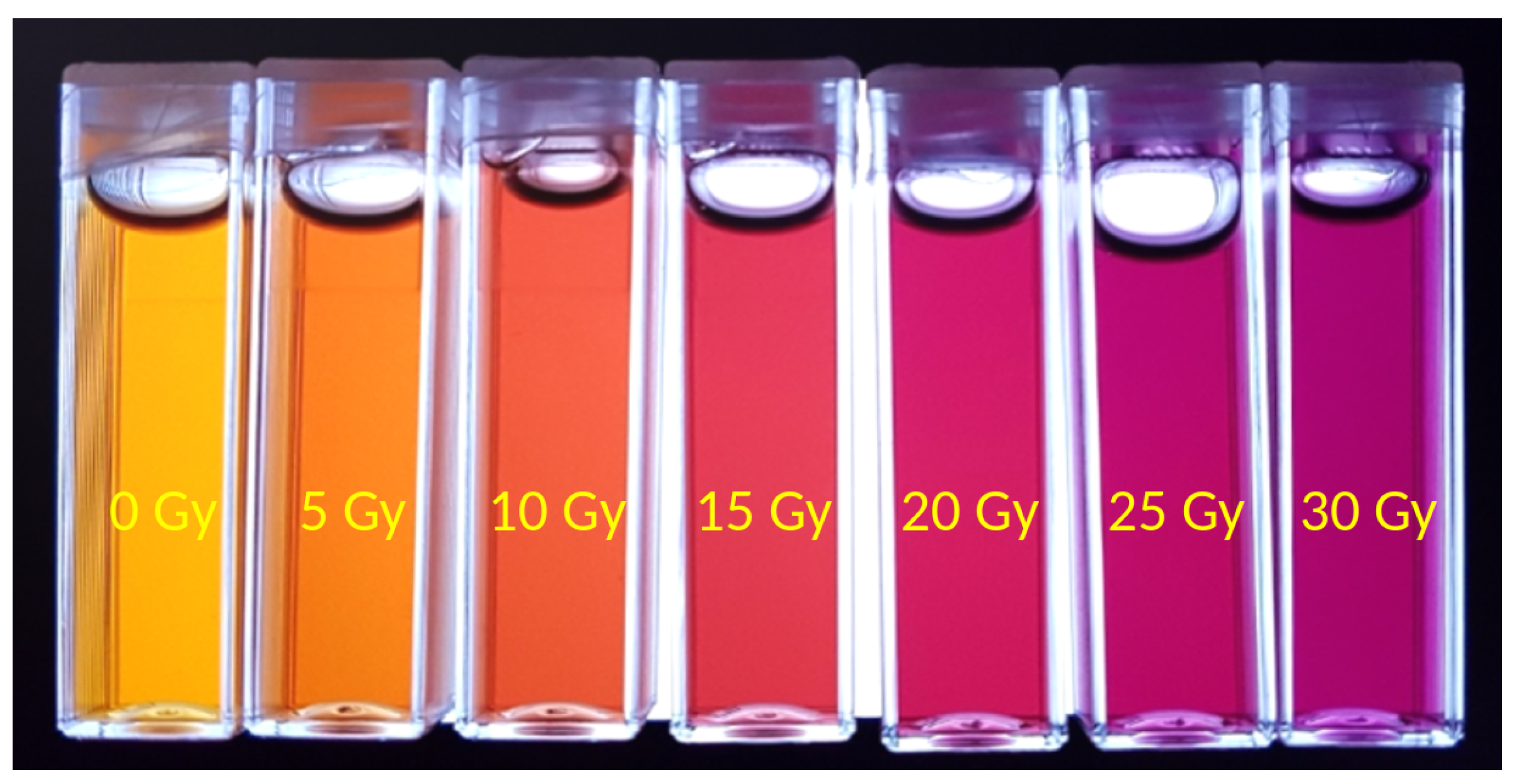
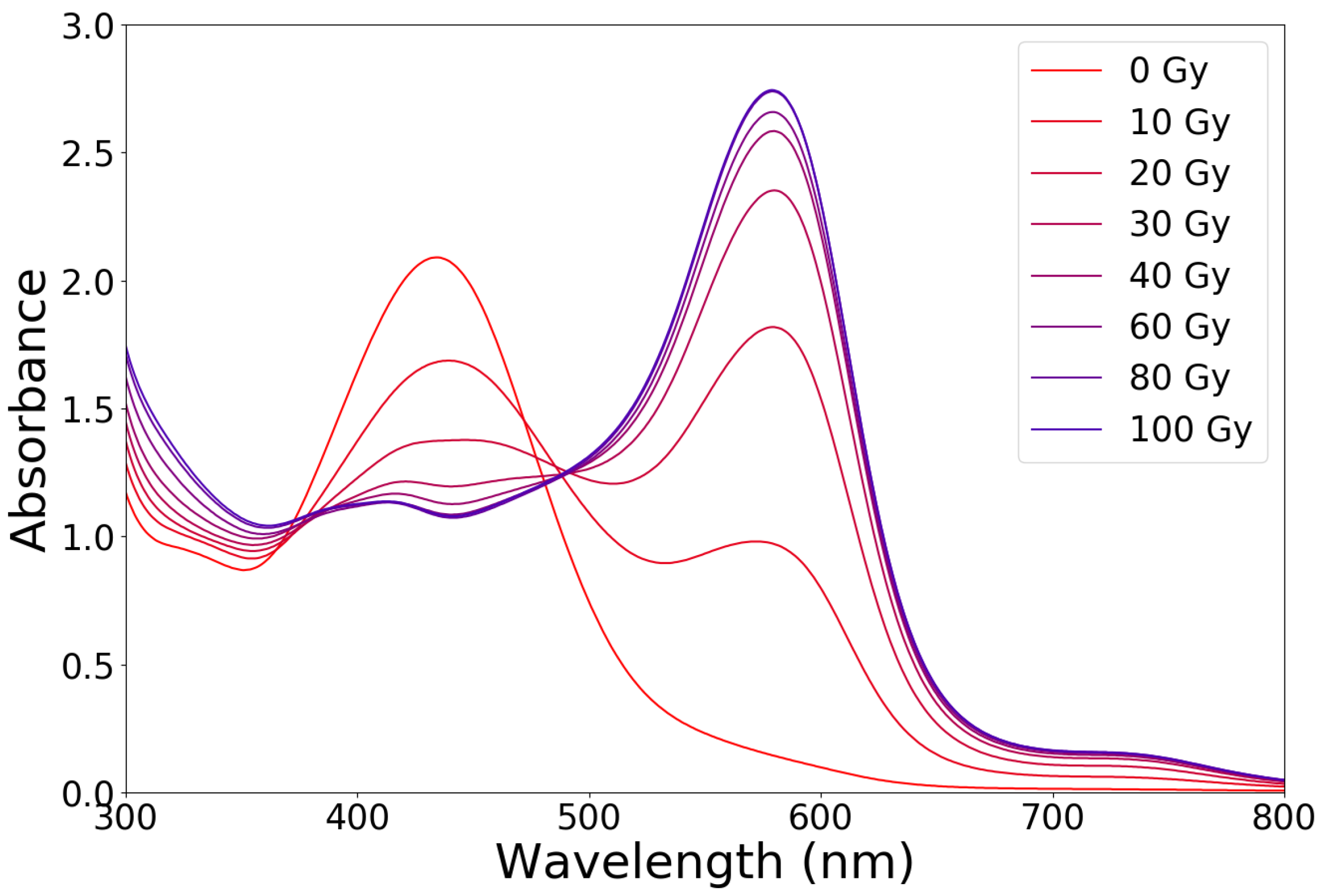
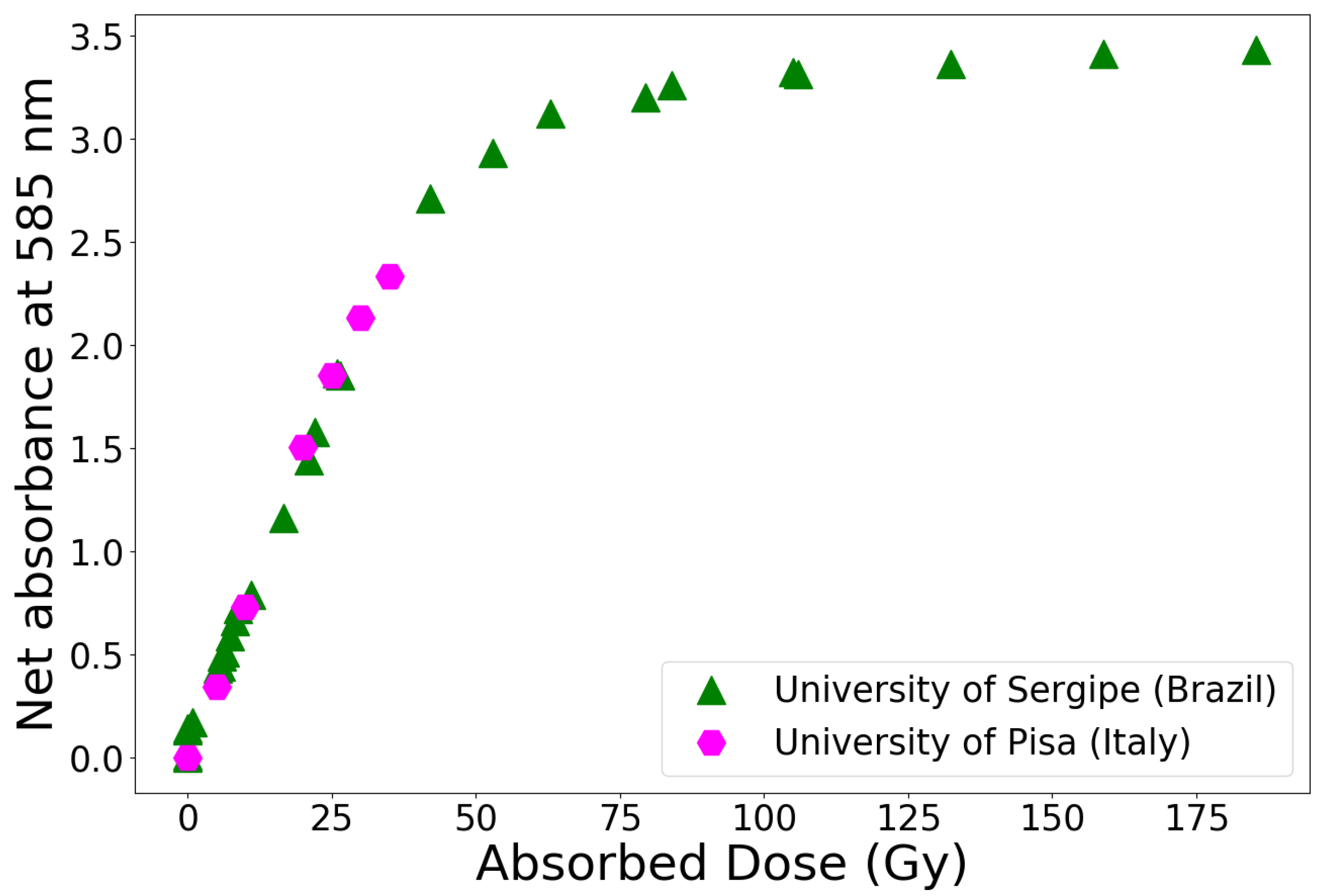
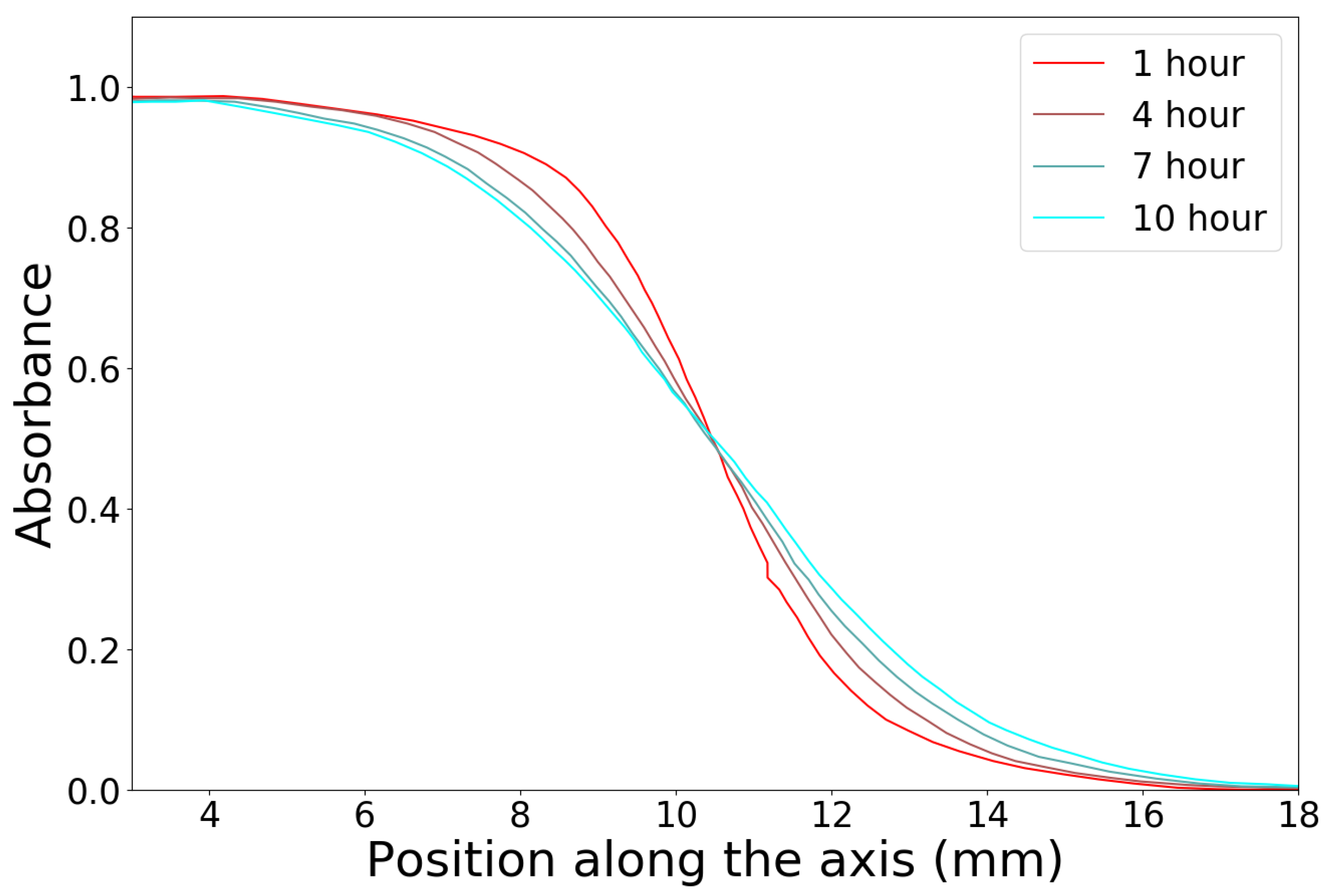
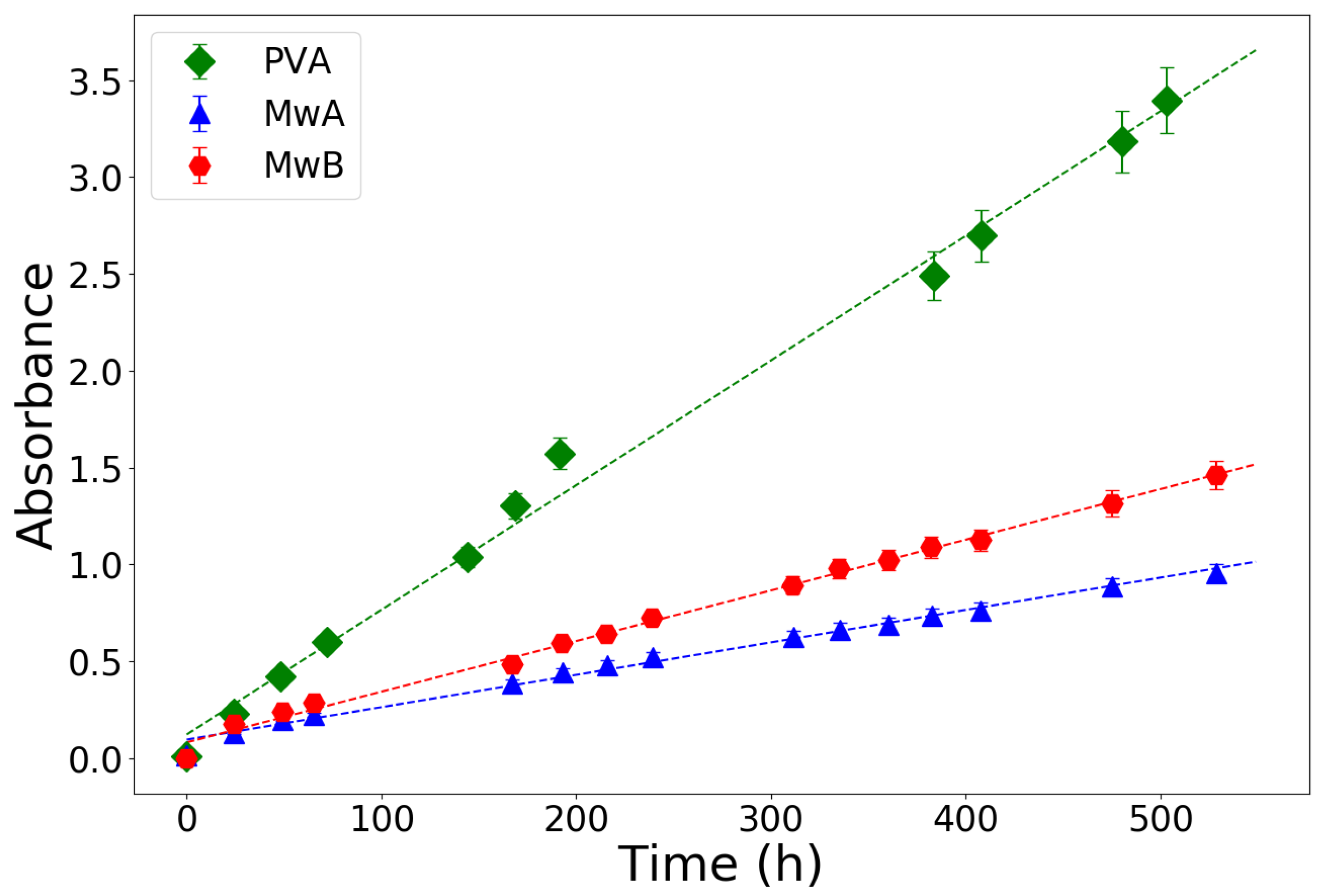

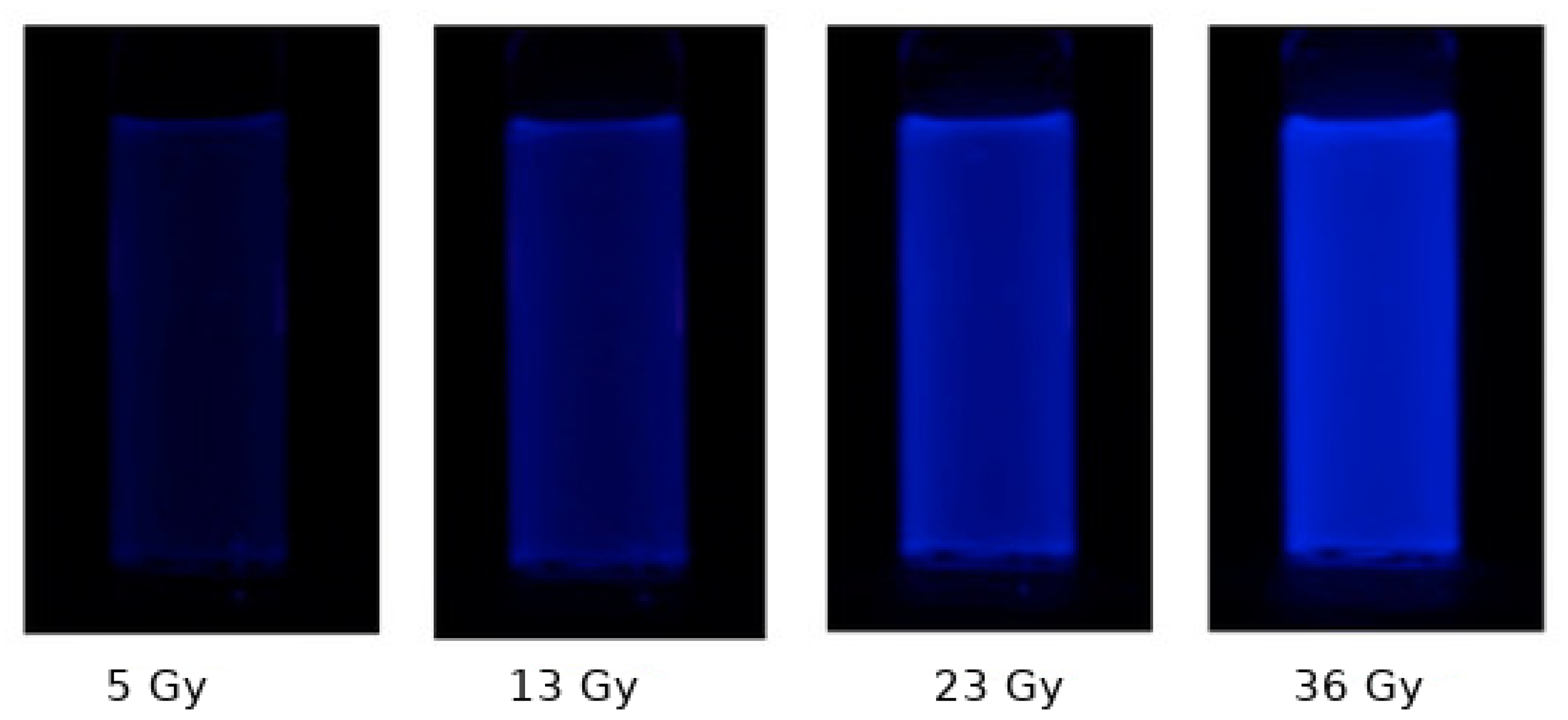
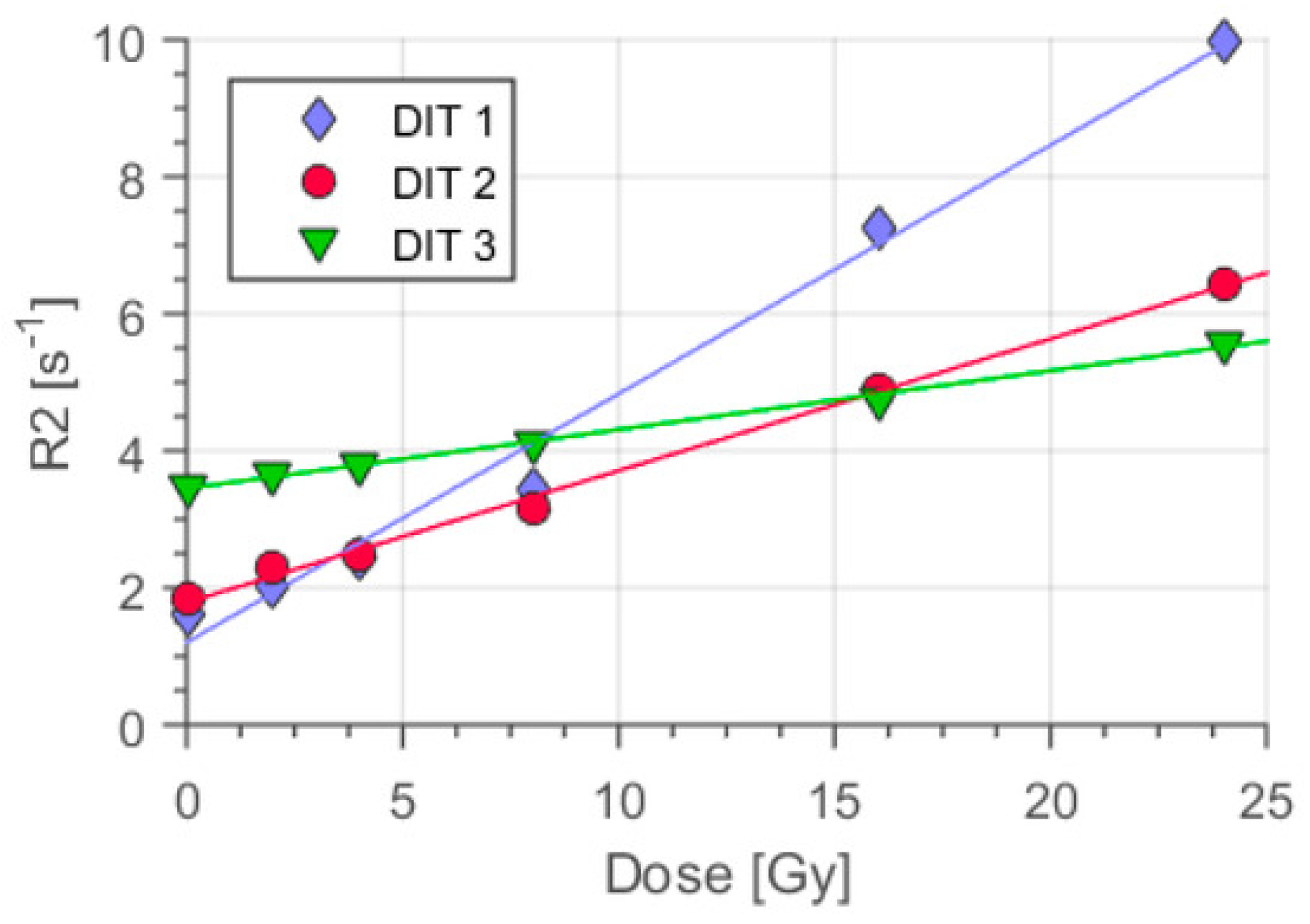
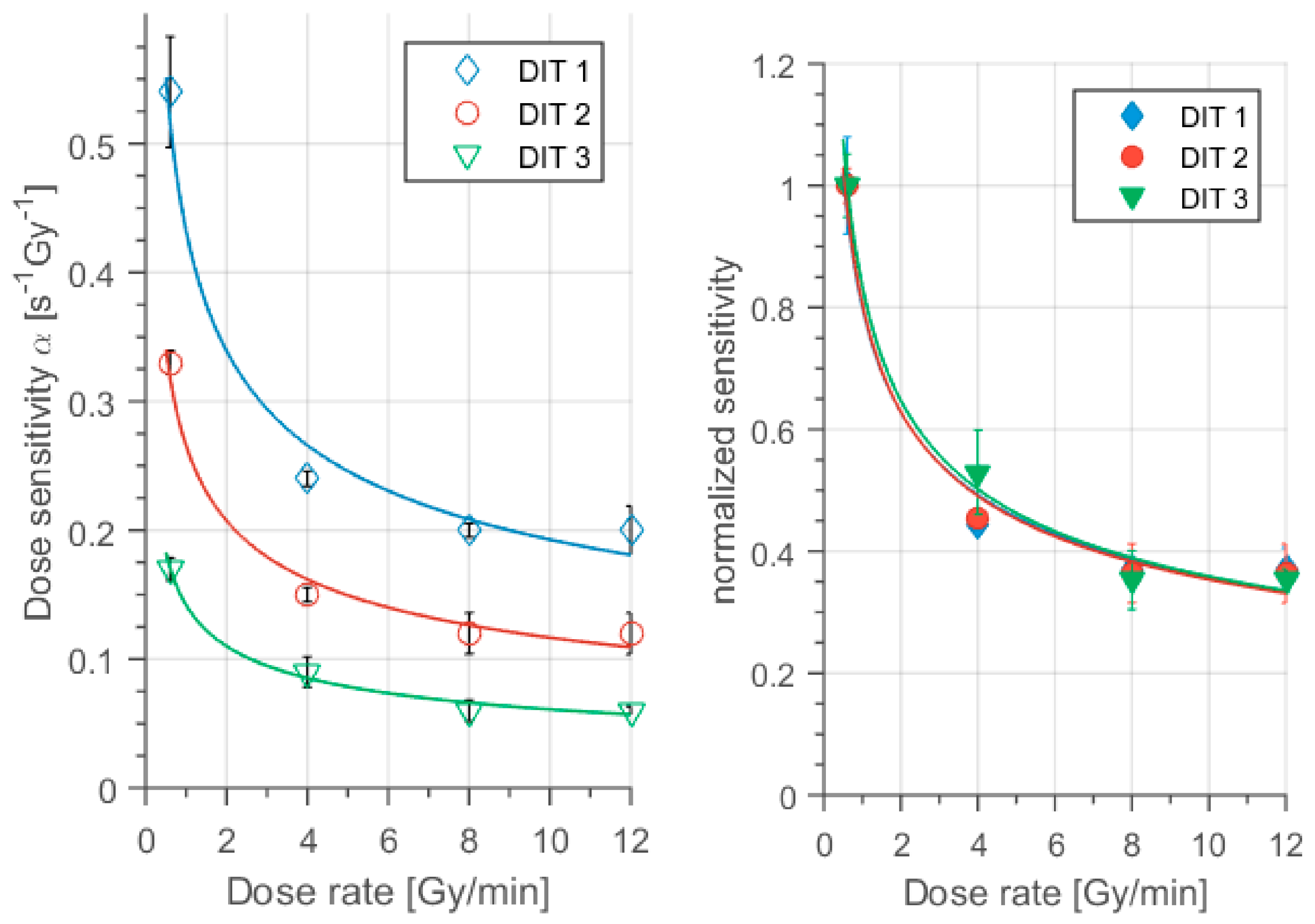
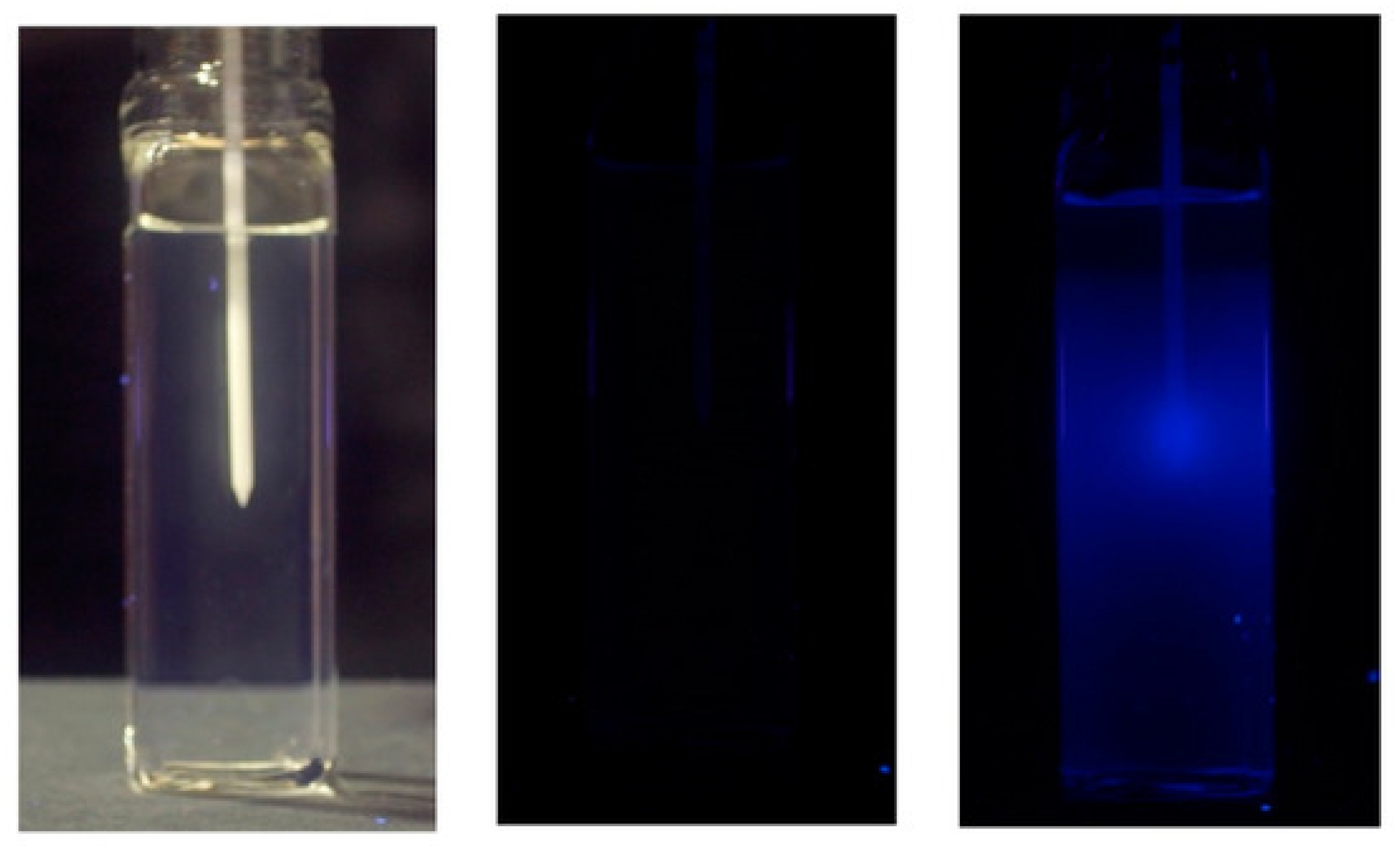
| GTA (mM) | Temperature (°C) | Gelation Time (min) |
|---|---|---|
| 13.25 | 15 | N/A |
| 26.5 | 15 | N/A |
| 53 | 15 | 30 |
| 13.25 | 20 | 75 |
| 26.5 | 20 | 35 |
| 53 | 20 | 25 |
| 13.25 | 25 | 25 |
| 26.5 | 25 | 20 |
| 53 | 25 | 10 |
| PVA Type | PVA Concentration | Molecular Weight | GTA Concentration | Diffusion Coefficient |
|---|---|---|---|---|
| (% w/v) | (×103) | (mM) | (mm2h−1) | |
| PVA-A | 10% | 85–124 | 26.5 | 0.171 ± 0.012 |
| PVA-B | 10% | 85–124 | 6.625 | 0.249 ± 0.029 |
| PVA-C | 10% | 31–50 | 26.5 | 0.200 ± 0.018 |
| PVA-D | 10% | 13–23 | 26.5 | 0.291 ± 0.033 |
| Mw-A | 10% | 125 | 26.5 | 0.184 ± 0.014 |
| Mw-B | 12.50% | 125 | 33.125 | 0.152 ± 0.008 |
| Gel Matrix | Sensitivity | Diffusion Coefficient | Spontaneous Oxidation |
|---|---|---|---|
| (Gy−1) | (mm2 h−1) | (h−1) | |
| PVA-GTA (Mw-B) | 0.077 ± 0.001 (1s.e.) | 0.152 ± 0.008 (1s.d.) | 2.60 × 10−4 |
| 20% PVA hydrogel [46] | 0.046 (uncertainty not reported) | 0.140 ± 0.002 | 1.3 × 10−4 |
| 20% functionalized PVA [48] | 0.014 (uncertainty not reported) | 0.130 ± 0.004 | – |
| Natural polymers (various types and concentrations) | 0.065–0.075 | 0.3–2.2 | 2.3 × 10−3 |
| [16,40,46,47,49] | (uncertainty reported as standard errors) |
Publisher’s Note: MDPI stays neutral with regard to jurisdictional claims in published maps and institutional affiliations. |
© 2021 by the authors. Licensee MDPI, Basel, Switzerland. This article is an open access article distributed under the terms and conditions of the Creative Commons Attribution (CC BY) license (https://creativecommons.org/licenses/by/4.0/).
Share and Cite
Marrale, M.; d’Errico, F. Hydrogels for Three-Dimensional Ionizing-Radiation Dosimetry. Gels 2021, 7, 74. https://doi.org/10.3390/gels7020074
Marrale M, d’Errico F. Hydrogels for Three-Dimensional Ionizing-Radiation Dosimetry. Gels. 2021; 7(2):74. https://doi.org/10.3390/gels7020074
Chicago/Turabian StyleMarrale, Maurizio, and Francesco d’Errico. 2021. "Hydrogels for Three-Dimensional Ionizing-Radiation Dosimetry" Gels 7, no. 2: 74. https://doi.org/10.3390/gels7020074
APA StyleMarrale, M., & d’Errico, F. (2021). Hydrogels for Three-Dimensional Ionizing-Radiation Dosimetry. Gels, 7(2), 74. https://doi.org/10.3390/gels7020074







